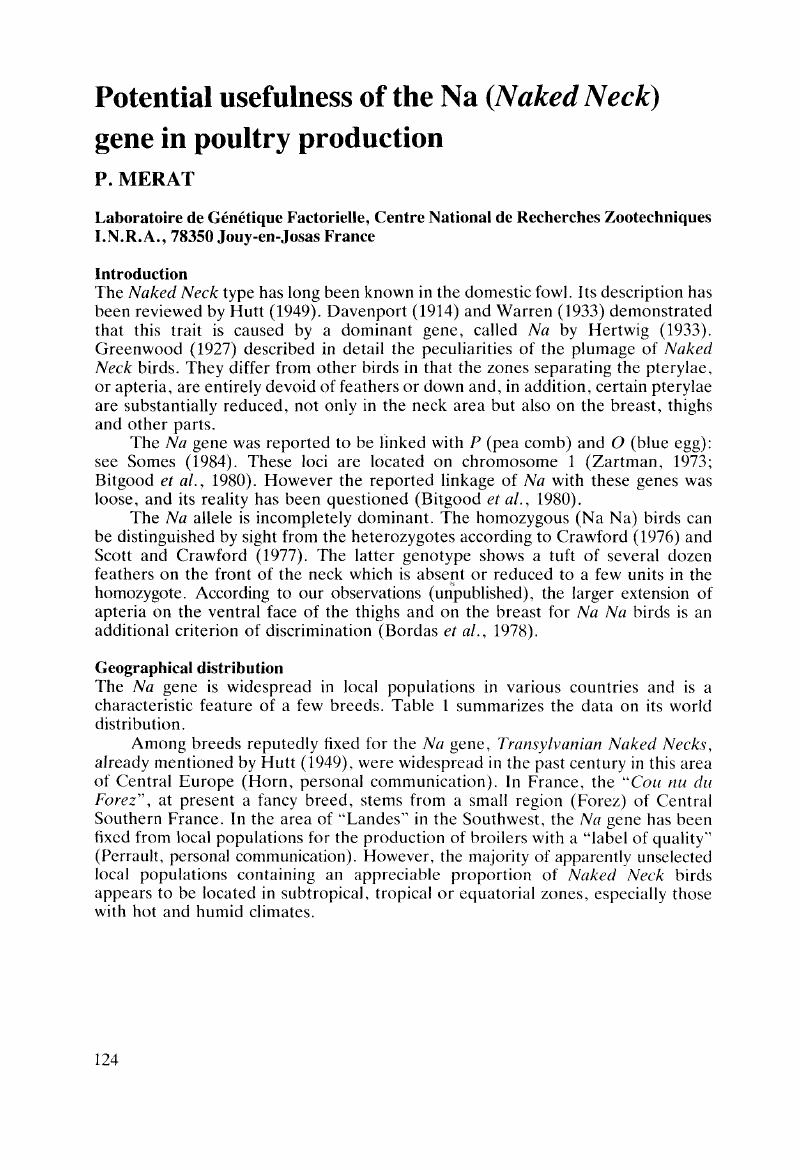Crossref Citations
This article has been cited by the following publications. This list is generated based on data provided by Crossref.
Decuypere, E.
Buyse, J.
Mérat, P.
Zoons, J.
and
Vloeberghs, J.
1993.
Growth, abdominal fat content, heat production and plasma hormone levels of naked-neck and control broiler chickens.
Animal Science,
Vol. 57,
Issue. 03,
p.
483.
EBERHART, D.E.
and
WASHBURN, K.W.
1993.
Assessing the Effects of the Naked Neck Gene on Chronic Heat Stress Resistance in Two Genetic Populations.
Poultry Science,
Vol. 72,
Issue. 8,
p.
1391.
EBERHART, D.E.
and
WASHBURN, K.W.
1993.
Variation in Body Temperature Response of Naked Neck and Normally Feathered Chickens to Heat Stress.
Poultry Science,
Vol. 72,
Issue. 8,
p.
1385.
CAHANER, AVIGDOR
DEEB, NADER
and
GUTMAN, MICHAL
1993.
Effects of the Plumage-Reducing Naked Neck (Na) Gene on the Performance of Fast-Growing Broilers at Normal and High Ambient Temperatures.
Poultry Science,
Vol. 72,
Issue. 5,
p.
767.
Howlider, M. A.R.
Begum, F.
Islam, M. S.
and
Wahid, M. A.
1995.
Feathering and Meat Yield of Full Feathered and Naked Neck Indigenous Chicken of Bangladesh.
Journal of Applied Animal Research,
Vol. 8,
Issue. 2,
p.
191.
Yalçin, S.
Özkan, S.
Açikgöz, Z.
and
Özkan, K.
1996.
Effect of dietary protein content on live and carcase performance of heterozygous naked neck and normally feathered broilers.
British Poultry Science,
Vol. 37,
Issue. 5,
p.
963.
Yancovich, A
Levin, I
Cahaner, A
and
Hillel, J
1996.
Introgression of the avian naked neck gene assisted by DNA fingerprints.
Animal Genetics,
Vol. 27,
Issue. 3,
p.
149.
Yalcin, S
Testik, A
Ozkan, S
Settar, P
Celen, F
and
Cahaner, A
1997.
Performance of naked neck and normal broilers in hot, warm, and temperate climates.
Poultry Science,
Vol. 76,
Issue. 7,
p.
930.
Barua, Animesh
and
Yoshimura, Yukinori
1997.
Rural poultry keeping in Bangladesh.
World's Poultry Science Journal,
Vol. 53,
Issue. 4,
p.
387.
Barua, Animesh
Howlider, M.A.R.
and
Yoshimura, Yukinori
1998.
Indigenous Naked neck fowl of Bangladesh.
World's Poultry Science Journal,
Vol. 54,
Issue. 3,
p.
279.
YALCIN, S.
1998.
Effect of season and dietary energy concentration on composition and strength of skin in naked neck fowl.
British Poultry Science,
Vol. 39,
Issue. 5,
p.
627.
Singh, B.
Singh, B. P.
Singh, Suneel
Chaudhuri, D.
and
Malik, C.
1998.
Naked Neck: A Noble Gene for Broiler Production in Tropical Climate.
Journal of Applied Animal Research,
Vol. 13,
Issue. 1-2,
p.
37.
BEAUMONT, C.
GUILLAUMIN, S.
GERAERT, P.A.
MIGNON-GRASTEAU, S.
and
LECLERCQ, B.
1998.
Genetic parameters of body weight of broiler chickens measured at 22°C or 32°C.
British Poultry Science,
Vol. 39,
Issue. 4,
p.
488.
Yunis, R
and
Cahaner, A
1999.
The effects of the naked neck (Na) and frizzle (F) genes on growth and meat yield of broilers and their interactions with ambient temperatures and potential growth rate.
Poultry Science,
Vol. 78,
Issue. 10,
p.
1347.
Mallia, J.G.
1999.
The Peel-Neck chicken of Belize and Guatemala, Central America.
Animal Genetic Resources Information,
Vol. 25,
Issue. ,
p.
71.
Yalcin, S.
Ozkan, S.
Acikgoz, Z.
and
Ozkan, K.
1999.
Effect of dietary methionine on performance, carcase characteristics and breast meat composition of heterozygous naked neck (Na/na+) birds under spring and summer conditions.
British Poultry Science,
Vol. 40,
Issue. 5,
p.
688.
Deeb, N
and
Cahaner, A
1999.
The effects of naked neck genotypes, ambient temperature, and feeding status and their interactions on body temperature and performance of broilers.
Poultry Science,
Vol. 78,
Issue. 10,
p.
1341.
Singh, C.V.
Kumar, D.
and
Singh, Y.P.
2001.
Potential usefulness of the plumage reducing Naked Neck (Na) gene in poultry production at normal and high ambient temperatures.
World's Poultry Science Journal,
Vol. 57,
Issue. 2,
p.
139.
Silva, MAN
Silva, IJO
Piedade, SMS
Martins, E
Coelho, AAD
and
Savino, VJM
2001.
Resistência ao Estresse Calórico em Frangos de Corte de Pescoço Pelado.
Revista Brasileira de Ciência Avícola,
Vol. 3,
Issue. 1,
p.
27.
Deeb, N.
and
Cahaner, A.
2001.
Genotype-by-Environment Interaction with Broiler Genotypes Differing in Growth Rate. 1. The Effects of High Ambient Temperature and Naked-Neck Genotype on Lines Differing in Genetic Background.
Poultry Science,
Vol. 80,
Issue. 6,
p.
695.



